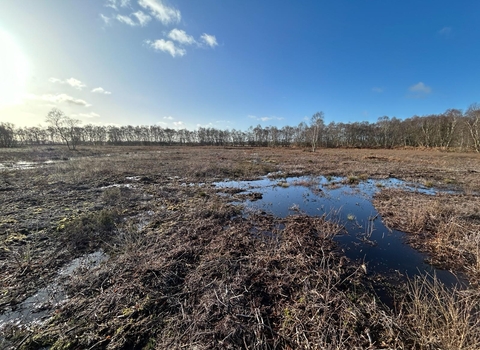Restoring South Yorkshire's peatland heritage
We're on a mission to revive South Yorkshire's precious peatlands. From Hatfield and Thorne Moors, to Potteric Carr and multiple farms across the Humberhead Levels - we're working tirelessly to restore these vital landscapes.
Peatlands are iconic landscapes that provide a whole host of benefits. They act as natural flood management systems, biodiversity hotspots and have a deep historical and cultural value for the communities that enjoy them and rely on them.
Peatlands cover just 3% of the worlds surface but hold nearly 30% of the soil carbon. However, our peatlands are severely degraded through various land uses such as cutting of peat for horticulture and intensive farming on peat. While the importance of peat is now becoming more known there is great need to help out peatlands with habitat restoration works in order to kick start their recovery. Which is where the Nature for Climate Peatland restoration Grant comes in.
What are our aims for this project?
The aims of the grant are to:
- Reduce emissions from peat by 5.7 megatonnes of carbon dioxide equivalents cumulatively by 2050
- Establish the process of restoring 35,000 hectares of degraded peat in England by March 2025
- Provide wider benefits such as improved ecosystems and biodiversity, better water quality, natural flood management, protection of historic environment features, and connecting people with nature
What our work entails
Our work started with the discovery phase of the project, conducting a variety of surveys including peat depth, vegetation, LiDAR and water depth. This helped us understand the state the peat was currently in and helped informed our plans on how best to restore them.
We then moved into the restoration phase of the project where we have been carrying out various works on site to help restore the peatlands.
These have included:
- Installing water control structure such as tilting weirs, peat bunding, sluices and dams to help keep the water levels at the best height to allow the peat to stay water logged creating the conditions for more peat to form naturally
- Planting sphagnum mosses, a vital peat forming species, in areas where those species have been lost
- Removal of invasive Rhododendron which shades out the good peat vegetation and dries up the peat
The works we are doing will help give the land the building blocks to be able to recover and be able to be able to become a functioning peatland once more. There is so much more to do and we look forward to sharing our progress

